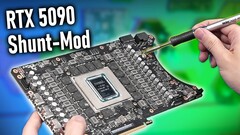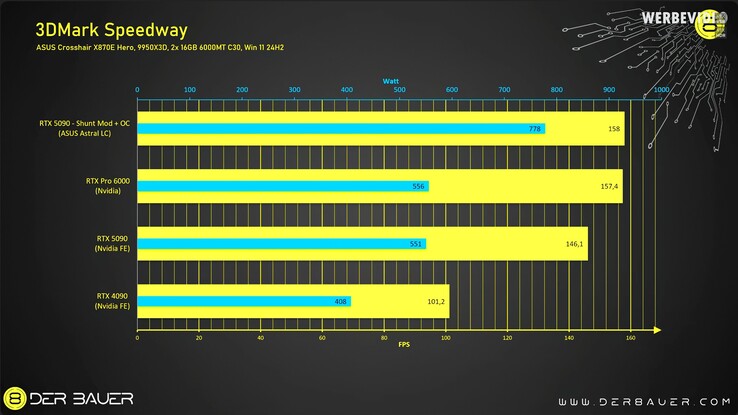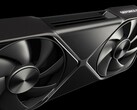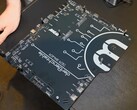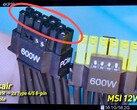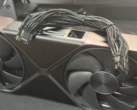The liquid-cooled Asus RTX 5090 Astral LC has been tested with a hardware-level shunt mod to evaluate how much performance can be unlocked by overriding the standard 600-watt power limit. Roman “der8auer” Hartung performed the modification and shared detailed benchmarks, thermals, and electrical measurements using GPU Tweak III, HWInfo, and external power monitoring.
Out of the box, the RTX 5090 Astral LC runs at 600 watts under full load and delivers around 146 FPS in 3DMark Speedway, with core clocks near 2800 MHz and memory at 1750 MHz. Despite its AIO cooler, the card stays below 60 °C on the core, although memory temperatures peak at 80 °C. Noise levels remain acceptable due to the absence of a blower-style rear fan seen in the air-cooled variant.
To bypass the power ceiling, der8auer added 5 milliohm shunt resistors in parallel to the GPU’s onboard 2 milliohm resistors. This reduced the effective resistance to around 1.4 milliohms, tricking the power measurement circuit into underreporting actual draw by approximately 30%. As a result, total card power rose to 660–720 watts without the GPU registering a limit breach.
Following this mod, the GPU core clock increased by 100–110 MHz and performance jumped to 152 FPS. By pushing GPU voltage further with GPU Tweak III, power draw edged up to nearly 800 watts, yielding up to 158 FPS — beating Nvidia’s workstation-class RTX 6000 Ada card, which costs over 10000 USD. In final testing, GPU clocks remained steady above 2950 MHz under load with core temperatures around 60 °C and hotspot readings unavailable due to Nvidia’s software lockouts.
While the card survived these conditions without thermal throttling, current distribution across the 12VHPWR connector became increasingly unbalanced — with pin 6 drawing nearly 13.5 amps. Per-pin sensing via Asus's telemetry proved invaluable in identifying such electrical stresses.
This experiment shows that modest shunt modding can unlock meaningful performance gains in the RTX 5090 LC, particularly with liquid-cooled variants capable of managing 750–800 watts of sustained heat. However, der8auer advises against applying similar mods to air-cooled cards, which may struggle to dissipate the resulting thermal load safely. A custom loop or unlocked 1000 W BIOS could further expand performance potential, but with significantly higher risks.
Source(s)
der8auer on YouTube (embedded above)




